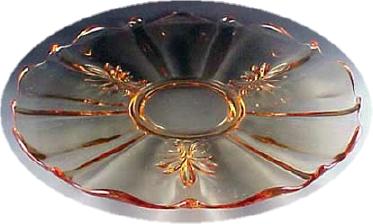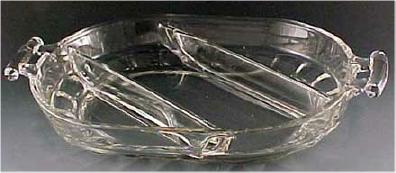National Depression Glass Association
Preserving America's Glass Manufacturing Heritage
Fostoria – Baroque and Raleigh Patterns
by Kathy Eickholt
Fostoria plain glass patterns are well-suited to today's
decorating themes of simplicity and shape; with the undecorated
blanks the beauty of the glass itself takes center stage. We'll
look at two of these this month, the fleur-de-lis Baroque design
and the colonial styled Raleigh. These two blank shapes are very
different from each other as both plain glass, and were used for
completely  different decorations. You won't mistake
these two patterns! Come back in future months for articles about
Century, and Sonata. If you enjoy elegant Fostoria glass these will
be useful to help understand the glass you see and appreciate.
different decorations. You won't mistake
these two patterns! Come back in future months for articles about
Century, and Sonata. If you enjoy elegant Fostoria glass these will
be useful to help understand the glass you see and appreciate.
Most Baroque pieces are unmistakable because they have the signature fleur de lis design. The torte plate shown at the top is a good example – you simply cannot mistake this for any other pattern. There are a few pieces that do not have the fleur de lis but even these can be distinguished easily. The cup is footed and plain; it is the handle that gives it away as Baroque with its wavy edge. The comport and low candlesticks also do not have the fleur de lis but have the cornucopia shaped stems. Once you see one of these pieces they really stand out.
Fostoria made Baroque from 1937 to 1958, primarily in crystal, but also pieces in light blue and gold tint, which is a medium topaz color. Crystal came in a full dinner set with many accessory pieces such as candleholders, comports, candy dishes, relish trays, lidded jars, console bowls and so on. There is much less blue available and it was primarily used with etchings and in accessory or serving pieces. We have seen more blue serving pieces – bowls, mayo sets and the like - than plates or cups. Gold tint was used for only a few pieces. The torte plate pictured is gold tint and it's the only piece of gold tint Baroque we have seen.
Baroque looks wonderful etched as the fleur de lis design seems to augment the design instead of fighting it. We have Baroque pieces with the Lido and Chintz etchings. These were extensive patterns that many people enjoy collecting and using and they are beautiful. You also can find Baroque etched with Navarre, Meadow Rose and Shirley. In fact, Fostoria used Baroque for most of their etched and cut designs released during the 1940s and early 1950s. Baroque takes designs so beautifully that other companies used it for their decorations, such as silver encrustations or gold overlays.
Baroque is not particularly prone to damage although the plain centers on plates can get worn. The heavily molded stems on comports and candleholders can get nicked but really it is quite sturdy. We had a creamer and sugar with Silver City's Blossom Time silver overlay design and the set weighed over three pounds. That is heavy glass!
 We
picked Raleigh as the other pattern for this discussion because it
is almost a complete opposite even though it was made during the
same period. Where Baroque gives the appearance of all curves and
airy elegance, Raleigh has the colonial styling so popular in the
1950s and 60s. It looks solid and square.
We
picked Raleigh as the other pattern for this discussion because it
is almost a complete opposite even though it was made during the
same period. Where Baroque gives the appearance of all curves and
airy elegance, Raleigh has the colonial styling so popular in the
1950s and 60s. It looks solid and square.
Raleigh has fluted panels on each piece usually between the rim and the center, and neat handles that look like little smooth round logs. It's pretty easy to identify but be aware that there are other patterns with fluted panels; Raleigh panels are quite small and slightly rounded. You can see this in the relish tray shown in the picture.
Fostoria made Raleigh from 1939 to 1956 and made it only in crystal. This production period was after the big color surge of the late 1920s to 1930s and before the reintroduction of delicate azure. Raleigh came in a full dinner set, including serving pieces such as relish trays, creamers and sugars and serving bowls and trays. Fostoria did not make very many accessory pieces and in fact there are only two candleholders in Raleigh, vs. the large number of Baroque shapes.
Raleigh etches were those of the era, Willow, Sampler, and cuttings like Kimberly or Minuet. These look good on the solid style and fit the colonial theme. Etchings with graceful curves and swooping floral sprays, like Willowmere, would look out of place on this style.
Raleigh is not very common in this area and we have seen the creamer and relish tray only. This is surprising given that Fostoria made it for 17 years and we find more Fostoria locally by far than any other elegant glass maker.
Like Baroque, Raleigh does not damage easily. The little tips on the handles could get nicked but it is also quality glass that was made carefully with good crystal. The design doesn't have a lot of protruding edges or sharply defined lips on rims that will break, which makes this a good choice for families with children. Raleigh also is not very expensive compared to other Fostoria patterns, possibly because it is less well known or possibly because the generation that owned it new has not yet begun dispersing pieces among family members as the owners downsize. This would be a good pattern to collect if you like it.
Webmaster's NOTE: The NDGA wishes to thank the author for permission to use this article. Kathy is a dealer from Midland, Michigan. Her web site is Cat Lady's Glass.